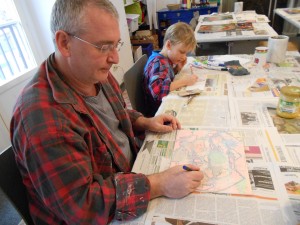 The practice of Structuristic Art Studies is based on an easy to learn development of systematically interwoven layers of color. Especially as far as this technique is concerned, the teaching of Structuristic Art distinguishes itself from traditional styles and schools of painting.
The practice of Structuristic Art Studies is based on an easy to learn development of systematically interwoven layers of color. Especially as far as this technique is concerned, the teaching of Structuristic Art distinguishes itself from traditional styles and schools of painting.
The beginner learns how to handle different painting supplies (primarily acrylic paints, graphite, felt tip pens and colored pencils as well as oil paint crayons). In the past twenty years, the paint industry has further evolved, so that many of today’s acrylic paints are perfect for the use as base paints.
Students also familiarize themselves with the use of different brush and spatula techniques. Opaque components, transparent surfaces, previously existing ornaments and individually drawn patterns are processed step-by-step and layer by layer to interweave them with each other.
As the artist’s board absorbs the water content that remains in the paint during the painting process, the water eventually evaporates. The evaporation process creates microscopically tiny hollow areas through which the light can penetrate the paintings. As a result of this simple physical phenomenon, an effect of great depth and the one-of-a-kind illuminative quality of Structuristic paintings is created.
Given that the process of evaporation of the water molecules and ever more intricate light penetration continues for quite a long time, Structuristic works do not reach their greatest expressive force until years after their completion.
Thanks to this technique, highly interesting and very autonomous works can be created in a very short time.


